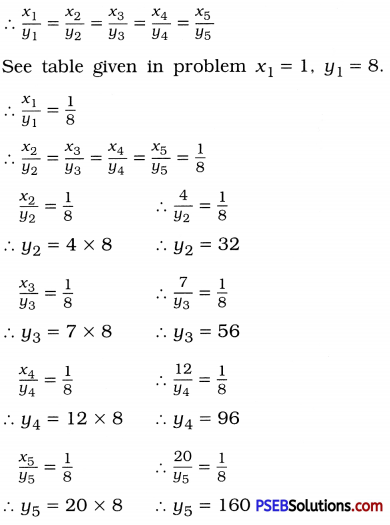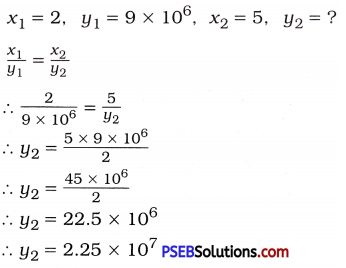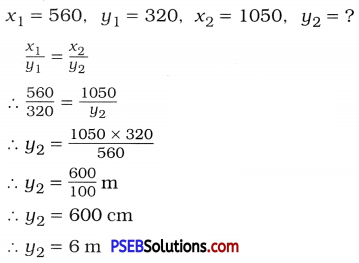Punjab State Board PSEB 8th Class Maths Book Solutions Chapter 13 Direct and Inverse Proportions Ex 13.1 Textbook Exercise Questions and Answers.
PSEB Solutions for Class 8 Maths Chapter 13 Direct and Inverse Proportions Ex 13.1
1. Following are the car parking charges near a railway station upto:

Check if the parking charges are in direct proportion to the parking time.
Solution:
Here, ratio of parking charges and parking time are as follow:
| Parking time | Parking charges | Parking charge / Parking time |
| 4 hours | ₹ 60 | \(\frac{60}{4}=\frac{15}{1}\) |
| 8 hours | ₹ 100 | \(\frac{100}{8}=\frac{25}{2}\) |
| 12 hours | ₹ 140 | \(\frac{140}{12}=\frac{35}{3}\) |
| 24 hours | ₹ 180 | \(\frac{180}{24}=\frac{15}{2}\) |
Here, \(\frac {15}{1}\) ≠ \(\frac {25}{2}\) ≠ \(\frac {35}{3}\) ≠ \(\frac {15}{2}\)
Thus, the parking charges are not in direct proportion to the parking time.
![]()
2. A mixture of paint is prepared by mixing 1 part of red pigments with 8 parts of base. In the following table, find the parts of base that need to be added:
Solution:
| Parts of red pigment | 1 | 4 | 7 | 12 | 20 |
| Parts of base | 8 | … | … | … | … |
If parts of red pigment are x1, x2, x3, x4 and x5 respectively, then parts of base are y1, y2, y3, y4 and y5 respectively. Here, it is clear that mixture preparation is in direct proportion.

Thus, the table is
| Parts of red pigment | 1 | 4 | 7 | 12 | 20 |
| Parts of base | 8 | 32 | 56 | 96 | 160 |
3. In Question 2 above, if 1 part of a red pigment requires 75 ml of base, how much red pigment should we mix with 1800 ml of base?
Solution:
See as per question 2 –
x1 = 1, y1 = 75, x2 = ? and yx2 = 1800
\(\frac{x_{1}}{y_{1}}=\frac{x_{2}}{y_{2}}\)
∴ \(\frac{1}{75}=\frac{x_{2}}{1800}\)
∴ x2 = \(\frac{1 \times 1800}{75}\)
∴ x2 = 24
Thus, 24 ml of red pigment should be mixed with 1800 ml of base.
![]()
4. A machine in a soft drink factory fills 840 bottles in six hours. How many bottles will it fill in five hours?
Solution:
Let the number of bottles filled by machine in 5 h be x.
| Number of hours (x) | 6 | 5 |
| Number of bottles filled (y) | 840 | ? |
Here, as the number of hours decreases, the number of bottles filled will also decrease.
∴ It is case of direct proportion.
Here, x1 = 6, y1 = 840, x2 = 5 and y2 = ?
\(\frac{x_{1}}{y_{1}}=\frac{x_{2}}{y_{2}}\)
∴ \(\frac{6}{840}=\frac{5}{y_{2}}\)
∴ y2 = \(\frac{5 \times 840}{6}\)
∴ y2 = 700
Thus, 700 bottles will be filled in 5 hours.
5. A photograph of a bacteria enlarged 50,000 times attains a length of 5 cm as shown in the diagram. What is the actual length of the bacteria? If the photograph is enlarged 20,000 times only, what would be its enlarged length?
Solution:
| Enlargement in picture of bacteria | Length (cm) |
| 50,000 times enlarged (x1) | 5 (y1) |
| 1 (x2) | ? (y2) |
Here, length of bacteria increases as picture of bacteria enlarges.
∴ It is case of, direct proportion.

Hence, the actual length of bacteria is 10-4 cm.
Now, the photograph is enlarged 20,000 times.
| Enlargement in picture of bacteria | Length (cm) |
| 50,000 times enlarged (x1) | 5 (y1) |
| 20,000 times enlarged (x1) | ? (y2) |
∴ \(\frac{50,000}{5}=\frac{20,000}{y_{2}}\)
∴ y2 = \(\frac{20,000 \times 5}{50000}\)
∴ y2 = 2
Thus, its enlarged length would be 2 cm.
![]()
6. In a model of a ship, the mast is 9 cm high, while the mast of the actual ship is 12 m high. If the length of the ship is 28 m, how long is the model ship?
Solution:
| – | Actual ship | Model ship |
| Length of the ship x | 28 m | ? |
| Height of mast y | 12m | 9 cm |
This is a case of direct proportion.
x1 = 28, y1 = 12, x2 = ?, y2 = 9
\(\frac{x_{1}}{y_{1}}=\frac{x_{2}}{y_{2}}\)
∴ \(\frac{28}{12}=\frac{x_{2}}{9}\)
∴ x2 = \(\frac{28 \times 9}{12}\)
∴ x2 = 21
Thus, the length of model ship is 21 cm.
7. Suppose 2 kg of sugar contains 9 × 106 crystals. How many sugar crystals are there in
Question (i)
5 kg of sugar?
Solution:
| Weight of sugar (kg) x | Number of sugar crystals y |
| x1 = 2 | y1 = 9 × 106 |
| x2 = 5 | y2 = (?) |
This is a case of direct proportion.

Thus, there are 2.25 × 107 crystals of sugar in 5 kg of sugar.
![]()
Question (ii)
1.2kg of sugar?
Solution:
| Weight of sugar (kg) x | Number of sugar crystals y |
| x1 = 2 | y1 = 9 × 106 |
| x2 = 1.2 | y2 = (?) |
Here. x1 = 2, x1 = 9 × 106, x2 = 1.2, y2 = ?
\(\frac{x_{1}}{y_{1}}=\frac{x_{2}}{y_{2}}\)
∴ \(\frac{2}{9 \times 10^{6}}=\frac{1.2}{y_{2}}\)
∴ y2 = \(\frac{1.2 \times 9 \times 10^{6}}{2}\)
∴ y2 = 0.6 × 9 × 106
∴ y2 = 5.4 × 106
Thus, there are 5.4 × 106 crystals of sugar in 1.2 kg of sugar.
8. Rashmi has a road map with a scale of 1 cm representing 18 km. She drives on a road for 72 km. What would be her distance covered in the map?
Solution:
| Actual distance (km) x | Distance on the map (cm) y |
| x1 = 18 | y1 = 1 |
| x2 = 72 | y2 = (?) |
This is a case of direct proportional.
Here, x1 = 18 km, y1 = 1 cm, x2 = 72 km, y2 = ?
\(\frac{x_{1}}{y_{1}}=\frac{x_{2}}{y_{2}}\)
∴ \(\frac{18}{1}=\frac{72}{y_{2}}\)
∴ y2 = \(\frac{72 \times 1}{18}\)
∴ y2 = 4
Thus, the distance covered by her on the map is 4 cm.
![]()
9. A 5 m 60 cm high vertical pole casts a shadow 3 m 20 cm long. Find at the same time
Question (i)
the length of the shadow cast by another pole 10 m 50 cm high
Solution:
| Height of vertical pole x | Length of shadow y |
| x1 = 5 m 60 cm = 560 cm | y1 = 3 m 20 cm = 320 cm |
| x2 = 10 m 50 cm = 1050 cm | y2 = (?) |
This is a case of direct proportionality.

Thus, the length of the shadow cast by another pole is 6 m.
Question (ii)
the height of a pole which casts a shadow 5 m long.
Solution:
| Height of vertical pole x | Length of shadow y |
| x1 = 560 cm | y1 = 320 cm |
| x2 = (?) | y2 = 5 m = 500 cm |
x1 = 560, y1 = 320, x2 = ?, y2 = 500
\(\frac{x_{1}}{y_{1}}=\frac{x_{2}}{y_{2}}\)
∴ \(\frac{560}{320}=\frac{x_{2}}{500}\)
∴ x2 = \(\frac{560 \times 500}{320}\)
∴ x2 = 875 cm
∴ x2 = 8.75 cm
Thus, the height of the pole is 8,75 m.
![]()
10. A loaded truck travels 14 km in 25 minutes. If the speed remains the same, how far can it travel in 5 hours?
Solution:
| Distance (km) x | Time (minute) y |
| x1= 14 | y1 = 25 |
| x2 = (?) | y2 = 5 hours = 300 |
This is a case of direct proportion.
∴ Here, x1 = 14, y1 = 25, x2 = ?, y2 = 300
\(\frac{x_{1}}{y_{1}}=\frac{x_{2}}{y_{2}}\)
∴ \(\frac{14}{25}=\frac{x_{2}}{300}\)
∴ x2 = \(\frac{14 \times 300}{25}\)
∴ x2 = 168
Thus, loaded truck can travel 168 km in 5 h.